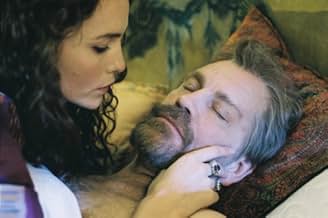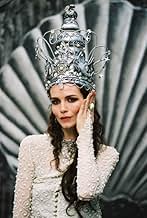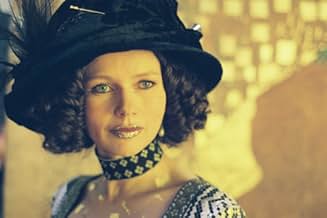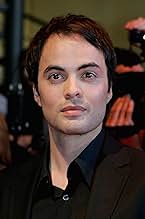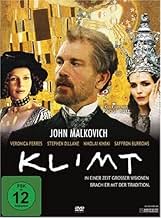Ajouter une intrigue dans votre langueA portrait of Austrian artist Gustav Klimt, whose lavish, sexual paintings came to symbolize the art nouveau style of the late nineteenth and early twentieth century.A portrait of Austrian artist Gustav Klimt, whose lavish, sexual paintings came to symbolize the art nouveau style of the late nineteenth and early twentieth century.A portrait of Austrian artist Gustav Klimt, whose lavish, sexual paintings came to symbolize the art nouveau style of the late nineteenth and early twentieth century.
- Réalisation
- Scénario
- Casting principal
- Récompenses
- 1 victoire et 4 nominations au total
Avis à la une
Hunter S. Thompson blew the journalistic world away by openly reporting events through the prism of his own drug-soaked experience. Terry Gilliam's cinematic portrayal of this in "Fear and Loathing in Las Vegas" conveyed this brilliantly.
So far as I know, Gustav Klimt did not portray his artistic vision in an ether-soaked stupor or in a state of syphilitic delirium. My problem with Mr. Ruiz portraying him as though he did is that Klimt actually led an exuberant revolutionary artistic movement in a city and continent exploding with creative energy, and this portrayal could hardly be farther from the truth. Even a non-linear poetic portrayal of the creative process should shed some truth on its essence.
The tone of the movie was static, suffocating, semi-conscious and joyless. Klimt's life was full of color, sexual experimentation and living life to its fullest, so it additionally seems odd that John Malkovich sleepwalks through his performance with less joy than Rod Steiger in "The Pawnbroker."
If Mr. Ruiz wanted to make a film about a fever-dream (Klimt died of pneumonia following a stroke, not of tertiary syphilis as suggested in the film), perhaps he should have entitled it "Fever-Dream: with a whimsical guest appearance by my fantasy of Gustav Klimt."
This film may be of use to film students to prove that images and sound do not automatically add up to a movie.
I didn't like this movie, and I have to say I admire Klimt paintings. I don't think that Klimt was so stiff and also sleepy. There is much more life in one simple photograph from the artist Wiki page, than in this whole movie. All these endless camera rotations around subjects! And too much too loud music... And actually an absence of scenario...
They tried to sell this movie to public - nudes, decadent atmosphere, this misleading label. The ratings show that they failed... I give it 5 for some visual enjoyment I had... and some women hats there were really-really amazing!
I can imagine that the reason many people didn't like this movie was because it's not what they expected.
If you want to see a straight forward, biographical accurate movie about the life of Gustav Klimt, then this movie isn't for you.
The basic premise is that Gustav Klimt is lying on his death bed and in a manner of flashbacks you get to see random scenes about a fictitious story revolving around a mysterious woman. Blinded by the fever, the scenes appear surreal and deliver a feeling similar to what you may feel upon viewing Klimt's artwork.
There's no straight plot following this movie and the real Klimt may not have been the way he appears in the movie, but that was never intended anyway. What this movie does is brilliantly deliver an atmosphere very fitting to the Wiener Moderne. The very important "Kaffeehaus Kultur" at the time, where intellectuals of Vienna spent the entire day in coffee houses is portrayed very precisely as well.
I also think that Malkovich and Nikolai Kinski seem to be a near perfect cast for Gustav Klimt and Egon Schiele.
Anyway, if you've read this review and get the feeling that this movie is not for you, then don't watch it. But if you're intrigued by what you've read then by all means, go see this movie!
The other actors are notable European actors whose works have generally not been seen in the United States. The notable German actress Veronica Ferres portrays Emily Floge; Klimt's lifelong companion. Again, unless you are familiar with the life of Klimt the role of Floge in this movie is very difficult to understand. And, it is never explained in the movie. Basically, Klimt and Floge were in-laws by the marriage of Gustav's brother to Emily's sister. The seemed to never have been "lovers" but the unmarried Emily seems to have been a wife (as well as business partner) to Gustav in every other respect. It was a complex relationship and Ferres explains in a side featurette ("The Making of Klimt") the difficulty of showing this relationship. The Austrian actress Aglaia Szyszkowitz portrays "Mizzi"; a model who bore two kids for Klimt of which one is shown- his son Gustav. He never married her, and the movie implies that he saw his kids only occasionally without financially supporting them in any noticeable manner. In real life Klimt did financially support his children by this woman. Of note is that the nickname for Emily Floge was "Middi" and the pronunciation of the two names is very similar; adding to the already considerable confusion.
The movie does portray Klimt in a negative manner concerning his offspring. He acknowledged paternity of four children and the movies deals with the other two as well as the two of Mizzi. Those children are dealt with almost as afterthoughts and one is positively embarrassing (perhaps the ultimate embarrassment). In reality Klimt probably had many more kids and this concern is mentioned briefly in the film. The film is certainly critical of Klimt in this regard; as well as his attitude towards women in general. There are some historical inaccuracies in this film such as a nurse in a Vienna hospital in early 1918 who has a VERY obvious British accent. This is highly unlikely, to say the least, to have been the case considering that the Austrians were in war with the British at that point, but overall the historical settings and costumes are well researched. The movie overall is well researched, but, again, quite confusing to somebody who is not very familiar with the life of this genius. I recommend that anybody who wants to see the film to first read up and look at the artworks of Klimt. Then the film will make sense and be seen as the superb achievement it is.
Le saviez-vous
- AnecdotesRyan Phillippe was considered for the role of Klimt.
- GaffesWhen Klimt mashes the cake in the man's face, the icing on the man's face is not covering his right eye. In the next close-up shot, there is a large blob of icing covering the man's right eye. In the next long shot when Klimt starts to wipe the man's face, the icing is no longer covering the man's right eye again.
- Citations
Klimt: Who art thou Asked the guardian of the night From crystal purity I come Was my reply And great my thirst, Persephone Yet heeding thy decree I take to flight and turn, and turn again Forever right I spurn the pallid cypress tree Seek no refreshment at its sylvan spring but hasten on toward the rustling river of Mnemosyne Wherein I drink to sweet satiety And there, dipping my palms between The knots and loopings of its mazy stream I see again, as in a drowning swimmers dream All the strange sights I ever saw And even stranger sights no man has ever seen
- Versions alternativesA 131-minute-long Director's Cut was released theatrically in Austria and is available on DVD in the UK.
- ConnexionsReferenced in Ricardo Aronovich, avec mes yeux de dinosaure du cinéma (2011)
Meilleurs choix
- How long is Klimt?Alimenté par Alexa
Détails
- Date de sortie
- Pays d’origine
- Sites officiels
- Langues
- Aussi connu sous le nom de
- A Viennese Fantasy à la manière de Schnitzler
- Lieux de tournage
- Sociétés de production
- Voir plus de crédits d'entreprise sur IMDbPro
Box-office
- Montant brut aux États-Unis et au Canada
- 97 656 $US
- Week-end de sortie aux États-Unis et au Canada
- 2 332 $US
- 24 juin 2007
- Montant brut mondial
- 584 991 $US
- Durée2 heures 11 minutes
- Couleur
- Mixage
- Rapport de forme
- 1.85 : 1
Contribuer à cette page




